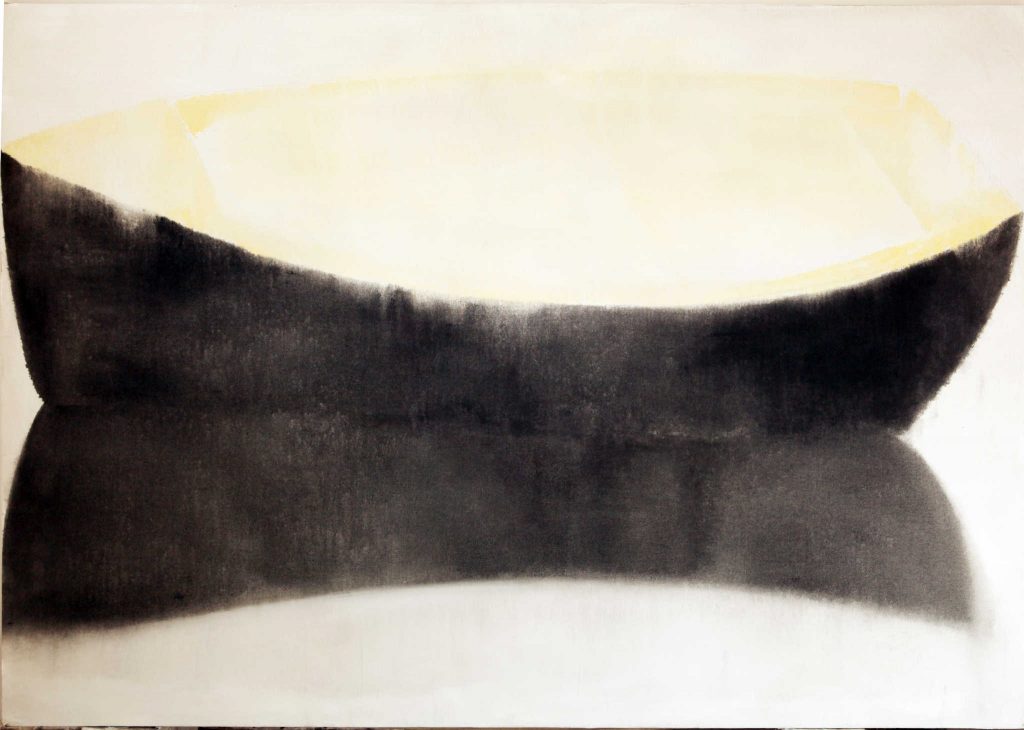Text: PAUL GLADSTON

◥ 船 2 | 布上丙烯
Boat II | Acrylic on canvas | 2013 | 140 x 200cm
Ekphrasis
Paintings and sculptural installations unseen, repre- sented by photographs sent from a distance. Both recall the characteristic formalities of Western(ized) minimalism-conceptualism: monochromatic washes on white grounds, sometimes accented by restrained applications of colour (light blue and yellow); rectangu- lar supports tending towards squares; extended hori- zontal geometric forms; and the presentation of indus- trially produced objects as ready-mades. Most of the paintings depict aspects of the connective machinery of contemporary urban life – the visually unremarkable outlets of air conditioning and heating systems, with their slats, cowls and partly obscured grilles – perhaps as a visual pun on works by the likes of Robert Ryman and Donald Judd. Another represents a rising staircase leading the eye back into the perspectival illusion of an
unadorned interior space. All assert an unavoidable decorative abstraction. One of the sculptural installa- tions extends the visual theme of the paintings, but this time turned inside out; its parallel duct-like forms (cov- ered entirely by an orderly grid of painted representa- tions of windows) can be read as surrealistically altered high-rise architectural exteriors. The other is an assist- ed ready-made involving the appropriation of two fab- ric carrying bags with handles whose outside surfaces carry a partial representation of the skin of a zebra. All of the paintings and installations are photographed within standard white cube gallery spaces, signifying (as a consequence of the inescapably hybrid nature of contemporary cultural production) an uncertainly ap- portioned combination of the unadorned liminality of Christian Protestantism and the meditative non-desir- ing of Chan/Zen Buddhism.
Theoria
According to a Marxian interpretative perspective, a truly revolutionary (avant-garde) art must – at the very least – keep pace with or even outstrip the historical development of the socio-economic base (which is, in relation to the unfolding of modernity, both accelerated and pervasively unsettling). Any sense of retrospec- tion or reliance upon established tradition is, on this account, tantamount to a betrayal of history insofar as it serves to present a detached and falsified (ideologi- cal) vision of life running against the grain of necessary forward looking socio-economic change. The paint- ings and installations described above are in step with
such a Marxian view insofar as they present images of contemporary urban life mediated through the use of modes of artistic production that can be understood as tending towards a mutually dislocating imbrication of art and life. At the same time, they are highly aestheti- cized works whose inescapably, auratic qualities point towards a trajectory of ritualistic separation from every- day life that is also supported by their showing within the context of the white cube’s ambient multi-cultural liminality. The artworks in questions can therefore be interpreted as pointing contrarily both in the direction of an incisive engagement with contemporary life and of a retreat from such an engagement-in other words, an uncertain combination of avant-garde and modern- ist-aesthetic tendencies.
Exegesis
Such a reading is, however, misleading when consid- ered in relation to the prevailing socio-political context of the People’s Republic of China. Since the confirma- tion of Deng Xiaoping’s programme of economic and social reforms at the third plenary session of the XI Central Committee of the Chinese Communist Party in December 1978, artists within the PRC have been implicated unavoidably in the opening up (reconstruc- tion) of a relatively autonomous artistic sphere after the highly restrictive blurring of boundaries between artis- tic production and society that took place during the Cultural Revolution. The historical trajectory of contem- porary art produced within the PRC over the last three decades has therefore been almost precisely opposite to that of the Western historical avant-gardes, which, notionally at least, sought to move critically against the exclusivity of an aestheticist bourgeois art by bringing artistic production into ever closer proximity with the life world. In light of which, it is possible to view the conspicuous aesthetisization of techniques associated
with Western(ized) art by contemporary Chinese artists within the context of the PRC not as a knowingly indeter- minate (postmodernist) divergence from the critical neg- ativity of the avant-garde, but as a potential reassertion of that negativity by other, locally significant means.
Paul Gladston is Associate Professor of Critical Theory and Vi- sual Culture in the Department of Culture, Film and Media at the University of Nottingham. Between 2005 and 2010, he was seconded to the University of Nottingham Ningbo, Chi- na as the inaugural head of the Department of international Communications and director of the institute of Comparative Cultural Studies.